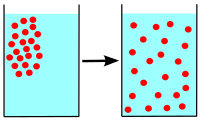
Photo from wikipedia
Abstract Two phase flow phenomena in fibrous media is studied using pore network modeling and visualized in 3D space. To explore the effect of network structure on flow property, virtual… Click to show full abstract
Abstract Two phase flow phenomena in fibrous media is studied using pore network modeling and visualized in 3D space. To explore the effect of network structure on flow property, virtual 3D fibrous mat with uniform and gradient porosity are constructed respectively using the realistic description of the complex fiber structure obtained from X-ray tomographic imaging. A marker-based watershed method is presented to extract pore networks directly from 3D segmented images. Invasion percolation algorithm is then applied to the extracted pore network to simulate primary drainage. The capillary pressure curve generated from drainage simulation is compared with an image-based full morphology method and achieves good agreement. The absolute and relative permeability are performed. For absolute permeability, we detected that the anisotropy of permeability tensor of layered fibrous mat can't be accurately reflected when pore cells are simplified using inscribed maximal balls. For relative permeability curves plotted as functions of water saturation, the results indicate a significant impact of the flow direction on liquid water distribution for porous material with gradient porosity.
Journal Title: Powder Technology
Year Published: 2019
Link to full text (if available)
Share on Social Media: Sign Up to like & get
recommendations!